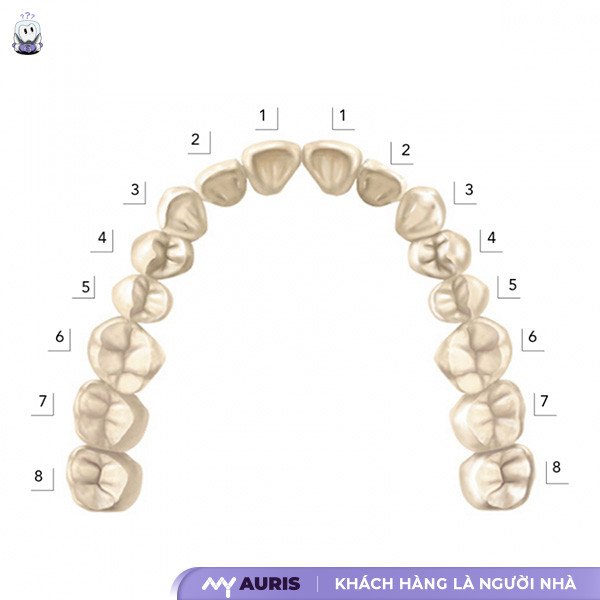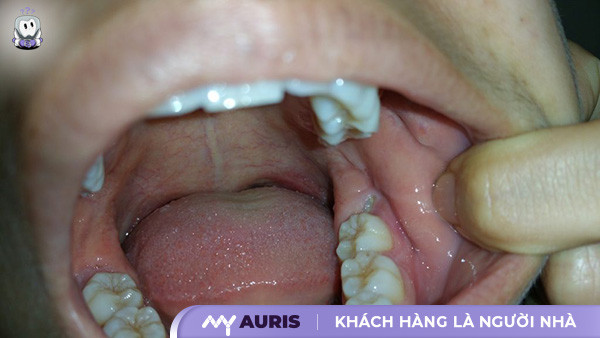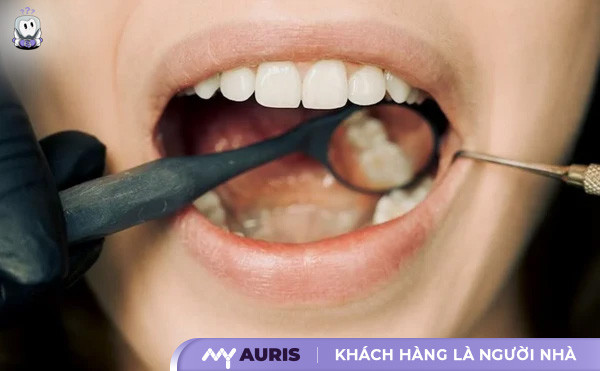Not everyone can grow all 4 wisdom teeth. In fact, many people only grow 1-2 or none at all. Despite being called wisdom teeth, they do not play an essential role in chewing function, nor do they significantly affect the aesthetics of the teeth. Understanding what wisdom teeth are, their impact on oral health, and how to promptly address any issues will help you proactively protect your smile and avoid dangerous complications. We invite you to explore the details with experts at My Auris Dental through the content below.
What is a wisdom tooth?
In reality, tooth number 8 is the wisdom tooth, the last tooth to erupt in the back of the mouth, usually appearing between the ages of 17 and 25. The name “tooth number 8” comes from it being the eighth tooth counting from the incisors, located deep within the oral cavity.
Despite modern advancements, medicine has yet to fully explain the late eruption of wisdom teeth or their exact role in the body. This makes dealing with and caring for wisdom teeth more complex than other teeth.
Typically, each person can have a maximum of 4 wisdom teeth: 2 in the lower jaw and 2 in the upper jaw, equally divided between both sides. However, not everyone grows all of them. Some individuals only develop 1, 2, or 3, and some never have any wisdom teeth throughout their lives.

Common wisdom tooth eruption patterns:
Straight Erupting Wisdom Tooth: This is the most ideal scenario. Although the pain and fever associated with eruption can be uncomfortable, these symptoms completely subside once the tooth has fully emerged. Straight-erupting wisdom teeth typically do not affect or invade adjacent teeth, making extraction rarely necessary.
Impacted Wisdom Tooth: This is a commonly encountered type. Since the tooth cannot be seen with the naked eye, patients usually only seek examination when pain occurs. X-rays are then needed to reveal their presence. This type of tooth carries a high risk of complications and is often recommended for extraction.
Angled/Misaligned Wisdom Tooth: This is the most common scenario, where the tooth does not erupt straight but invades the space of tooth number 7. During eruption, you may experience intense pain, and it can severely affect surrounding teeth, leading to widespread damage.
Signs of Wisdom Tooth Eruption: Early Detection for Timely Treatment
Dental X-rays are an effective method for detecting the first signs of an erupting wisdom tooth. Specifically, panoramic X-rays allow for imaging of all teeth and jaws in a single shot, thereby pinpointing the position of the wisdom tooth and determining if it is about to erupt.
However, even without an X-ray, you can often tell if a wisdom tooth is about to erupt by experiencing common uncomfortable symptoms. Common signs of wisdom tooth eruption include:
- Swollen gums, often appearing behind the second molars
- Jaw pain, which can be persistent or dull
- Bleeding gums, tender gums
- Difficulty opening the mouth wide
- Foul odor in the mouth, bad breath
- The pain is usually mild, but can sometimes be sharp, or pain when chewing with molars near where the wisdom tooth is erupting, causing discomfort during chewing
These symptoms are often a result of the wisdom tooth being impacted or trapped beneath the gums, especially when there isn’t enough space for it to fully erupt. If wisdom teeth erupt misaligned, they can also cause periodontal disease, damaging nearby teeth and the adjacent jawbone.
When a wisdom tooth erupts through the gums, patients may experience a slight fever, along with a small flap of gum tissue (pericoronal flap) in the area of the newly erupted wisdom tooth. While pain during wisdom tooth eruption is common, you should not be complacent if you encounter any of the following unusual signs:
- Bleeding gums with jaw pain, bleeding gums with swollen gums
- Persistent gum bleeding – potentially a sign of gum disease
- Loose teeth, misaligned teeth
- Gum recession
- Sores inside the mouth
- Cracked or fractured molars
- Damage to fillings, crowns, or bridges
- Gum swelling spreading to cheek swelling
If you experience any of the conditions mentioned above, please consult a dentist or an oral and maxillofacial surgeon for a thorough examination and timely treatment.

When Do Wisdom Teeth Erupt and What You Need to Know
Wisdom teeth, also known as third molars, typically begin to erupt between 17 and 25 years of age. These are the last permanent teeth to appear in the dental arch. However, not everyone develops wisdom teeth – some people never grow them, while others have wisdom teeth that erupt normally, just like other molars, and cause no oral health problems.
However, in most cases, wisdom teeth are impacted due to insufficient space in the jawbone or abnormal development. When wisdom teeth are affected, they may partially erupt or not erupt at all. Misaligned wisdom teeth can:
- Erupt at an angle towards the next tooth, i.e., the second molar
- Erupt at an angle towards the back of the mouth
- Erupt at a right angle to other teeth
- Erupt straight up or down like other teeth but become trapped within the jawbone
If this condition is not detected and treated early, it can lead to pain, infection, or damage to adjacent tooth structures. Therefore, if you are between 17 and 25 years old and show signs of wisdom tooth eruption, please visit a dentist for an X-ray examination of the eruption pattern to ensure normal development and prevent complications.
Common Wisdom Tooth Eruption Conditions to Be Aware Of
Vertical Impaction
The most common and least problematic wisdom tooth eruption condition is when the wisdom tooth erupts in the correct direction, also known as vertical impaction. In this case, the wisdom tooth grows straight like a normal tooth, causing no health problems, no pain, no gum inflammation, and no swelling. This is a good sign, indicating that the jawbone has sufficient space for the last permanent tooth to develop normally without affecting adjacent teeth.
Partial Impaction
When a wisdom tooth erupts only partially, also known as partial impaction, you may see the unaffected portion of the tooth fully visible above the gum line. However, the remaining part may be trapped within the gums or jawbone, making hygiene difficult. This can easily lead to oral health problems such as tooth decay, gum disease, and a risk of infection if not treated promptly.
Horizontal or Angled Impaction
In cases where a wisdom tooth erupts horizontally or at an angle, also known as horizontal impaction, the wisdom tooth is in the correct position to erupt but remains trapped beneath the gums. These horizontally impacted teeth often cause pain due to excessive pressure on the tooth in front. This is a fairly serious condition and usually requires early dental intervention to prevent damage to the jaw structure.

When to Extract and When Not to Extract Wisdom Teeth?
Dentists recommend wisdom tooth extraction based on each individual’s specific eruption condition. Not everyone who develops wisdom teeth needs them removed, but many cases warrant wisdom tooth extraction to prevent serious oral health problems.
Cases Where Wisdom Teeth Should Be Extracted
When there isn’t enough space in the jaw for wisdom teeth to erupt, they tend to grow crowded, misaligned, or at various angles, significantly impacting the jaw structure and adjacent teeth. Common conditions that lead dentists to recommend extraction include:
- Wisdom tooth fully embedded in the gums: This is an impacted tooth condition, which can lead to cyst formation, infection, and even damage to the root of tooth number 7.
- Wisdom tooth only partially erupted through the gums: Difficult to observe and clean, easily accumulates bacteria, leading to periodontitis and oral infections.
- Crowded wisdom tooth: If there is insufficient space, the tooth can damage adjacent teeth, causing them to loosen, bone loss, and a risk of tooth loss.
In cases where wisdom teeth have not fully erupted, or their roots are not fully formed, dentists recommend early extraction of misaligned wisdom teeth for faster recovery after surgery.
The American Dental Association also recommends intervention if the tooth area is painful, shows signs of soft tissue infection behind the tooth, or if cysts appear.
In summary, when should wisdom teeth be extracted? – When they cause obstruction, damage to other teeth, or pose a potential risk of long-term infection.
Cases Where Wisdom Teeth Should Not Be Extracted
When should wisdom teeth not be extracted? – If the wisdom tooth erupts evenly, is firmly aligned with the upper row of teeth, does not affect tooth number 7, and its shape does not cause concern, then removal is not necessarily required.
Furthermore, wisdom tooth extraction should be carefully considered for special populations such as:
Individuals with chronic conditions: blood clotting disorders, neurological diseases, diabetes, high blood pressure, heart disease, etc.
Pregnant women, breastfeeding women, or those during menstruation.





